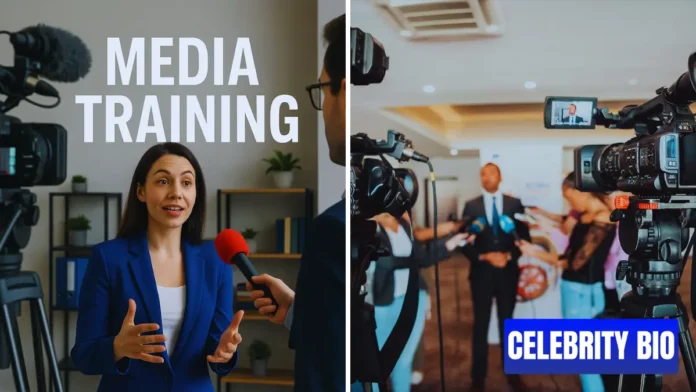In today’s hyperconnected world, every word you say in front of a camera, journalist, or microphone can shape public perception. That’s why media training has become an essential skill for professionals, executives, and spokespeople in the UK who need to communicate with confidence and clarity. Whether it’s a live TV interview, a podcast appearance, or a crisis statement, knowing how to deliver your message effectively can make or break your reputation.
Media training isn’t just about learning to “handle the press.” It’s about understanding how the media works, how to stay on message, and how to turn interviews into opportunities rather than threats. In this guide, we’ll explore everything you need to know — from the core principles of effective communication to advanced interview techniques, crisis handling, and expert insights that help you shine under pressure.
What Is Media Training and Why Does It Matter?
At its core, media training teaches individuals how to interact with journalists and communicate clearly in public forums. The goal isn’t to make you sound robotic but rather authentic, articulate, and in control of your message.
Whether you’re a CEO facing a press conference, a PR executive preparing a client for TV, or a charity spokesperson delivering an emotional story, media training equips you with tools to:
- Stay calm and confident under pressure
- Avoid misquotes or off-message answers
- Handle tough questions gracefully
- Protect and enhance your personal or brand reputation
In an age where a single clip can go viral within seconds, being unprepared is no longer an option.
The Core Principles of Effective Media Training
Great media performance isn’t luck — it’s built on a set of proven communication principles. Trainers often focus on these foundational skills:
- Message discipline: Know your three key messages and repeat them naturally throughout the interview.
- Bridging techniques: Learn to steer back to your message when faced with difficult or irrelevant questions.
- Body language: Maintain open posture, steady eye contact, and relaxed gestures — the camera picks up everything.
- Tone control: Use vocal warmth, avoid jargon, and adjust tone depending on the topic or audience.
- Authenticity: Audiences trust speakers who sound real. Don’t memorise scripts; internalise your key points instead.
These principles apply across all platforms — whether you’re speaking on national television, giving a radio interview, or being quoted for print.
How Media Training Helps During a Crisis
When a crisis hits, media attention can be relentless. The wrong statement can inflame the situation, while the right one can restore confidence and trust.
Crisis media training prepares leaders and communication teams to act quickly and strategically under pressure.
Key elements include:
- Rapid response planning: Knowing who will speak and what they’ll say before journalists call.
- Scenario simulations: Practising realistic crisis interviews to identify communication gaps.
- Empathy in messaging: Balancing transparency with reassurance — showing humanity without admitting liability.
- Consistency: Ensuring all team members speak with one unified voice.
A well-prepared spokesperson can transform a potential PR disaster into an opportunity to demonstrate accountability and leadership.
What to Expect in a Media Training Session
A professional media training session is often tailored to your role, experience, and industry. Typically, it includes:
- Theory and background: Understanding how journalists work, what makes a story newsworthy, and how interviews are edited.
- Practical exercises: On-camera mock interviews with playback and feedback.
- Message development: Refining your talking points into concise, quotable soundbites.
- Handling hostile questions: Learning techniques to defuse pressure and maintain composure.
- Confidence building: Breathing, pacing, and visualisation techniques to reduce anxiety.
By the end of a good session, participants leave with improved self-awareness, stronger delivery skills, and greater control over their public image.
Media Training for Executives and Spokespeople

Executives often face the toughest media environments — investor calls, shareholder meetings, or national broadcasts. For them, media training goes beyond performance coaching; it’s a leadership skill.
UK businesses increasingly expect senior leaders to embody their brand’s values in public. That means knowing how to communicate both authority and empathy.
Effective executive media training teaches how to:
- Present data or strategy in relatable terms
- Demonstrate credibility without arrogance
- Handle probing financial or ethical questions
- Connect emotionally with audiences
In short, it turns leaders into trusted communicators — an asset no balance sheet can quantify.
Media Training in the Digital Age
The landscape has changed dramatically. Interviews are no longer confined to newsrooms; they happen on Zoom, social media, and podcasts. Modern media training now includes digital communication skills, such as:
- Managing online interviews and lighting setups
- Understanding how clips are shared or edited online
- Responding to digital media coverage or social backlash
- Maintaining professionalism across LinkedIn, X (Twitter), and Instagram
Your online persona is an extension of your media image. Knowing how to navigate digital interviews and online reactions is now part of the job description for any modern spokesperson.
Real-World Examples: Lessons from the Best and the Worst
A few recent UK examples show how media training makes the difference between success and failure:
- Positive example: When airline executives calmly addressed disruptions during a travel crisis, their clarity and empathy won public trust despite the chaos.
- Negative example: A political spokesperson who dodged questions went viral for all the wrong reasons, becoming a meme instead of a messenger.
These contrasting outcomes underline a simple truth: how you say it matters just as much as what you say.
Choosing the Right Media Training Provider
Not all training is equal. When selecting a media training provider, consider:
- Trainer background: Look for former journalists or PR experts with real newsroom experience.
- Customisation: Avoid one-size-fits-all workshops. Your industry and spokesperson profile matter.
- Realistic simulations: Ensure the programme includes filmed interviews and playback analysis.
- Follow-up coaching: Ongoing feedback ensures improvement long after the session ends.
Reputable firms like Media First, Bluewood Training, or London Media Coach are known for offering professional, UK-focused programmes.
How Much Does Media Training Cost in the UK?
Prices vary based on trainer expertise and session format. On average:
- Half-day workshop: £600–£1,000 for small groups
- Full-day intensive: £1,200–£2,500
- Executive coaching: £3,000+ for bespoke one-to-one sessions
While it’s an investment, the ROI is undeniable. Just one confident, well-delivered interview can generate positive coverage worth tens of thousands in advertising value.
The ROI of Media Training: Why It Pays Off
From a business perspective, media training isn’t a cost — it’s an insurance policy for reputation. The benefits include:
- Increased media confidence among staff
- Greater message consistency
- Stronger brand credibility
- Improved crisis response times
- Enhanced leadership visibility
In an era where reputation drives revenue, training your key people to communicate clearly is one of the smartest moves you can make.
FAQs About Media Training
What is the main goal of media training?
To help individuals communicate clearly, confidently, and effectively with the media while protecting their brand’s reputation.
How long does media training take?
Sessions range from half a day to several days, depending on your needs and the complexity of your role.
Is media training only for executives?
No — it’s valuable for anyone likely to speak publicly or represent an organisation, including PR professionals, spokespeople, and subject experts.
Can media training help with social media interviews?
Absolutely. Modern courses include digital media communication, covering online interviews and social interactions.
How often should I refresh my media training?
Experts recommend a refresher every 12–18 months to stay updated on new media formats and communication trends.
Conclusion: Be Ready Before the Spotlight Finds You
In the modern information era, the spotlight can turn on anyone at any time — a viral tweet, a surprise journalist call, or an unexpected crisis. That’s why media training isn’t optional; it’s essential.
Investing in your communication skills ensures that when your moment arrives, you can deliver your message with confidence, clarity, and credibility. Whether you’re a corporate executive, a charity director, or a public figure, being prepared for the media means being ready to protect — and project — your best self.
Ready to take control of your message?
Consider booking a professional media training session today and turn every media encounter into an opportunity for influence.

